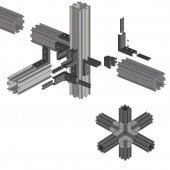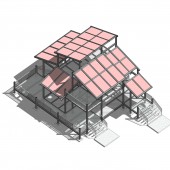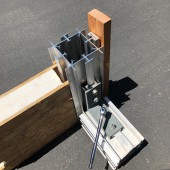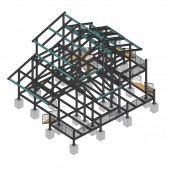
| THE AWARD |
| CATEGORIES |
| REGISTRATION |
| SUBMIT YOUR WORK |
| ENTRY INSTRUCTIONS |
| TERMS & CONDITIONS |
| PUBLICATIONS |
| DATES & FEES |
| METHODOLOGY |
| CONTACT |
| WINNERS |
| PRESS ROOM |
| GET INVOLVED |
| DESIGN PRIZE |
| DESIGN STORE |
| THE AWARD | JURY | CATEGORIES | REGISTRATION | PRESS | WINNERS | PUBLICATIONS | ENTRY INSTRUCTIONS |
Mhs Building Systems Structural Aluminum Framing Design by Tim Siahatgar |
Home > Winners > Design #148543 >Interview |
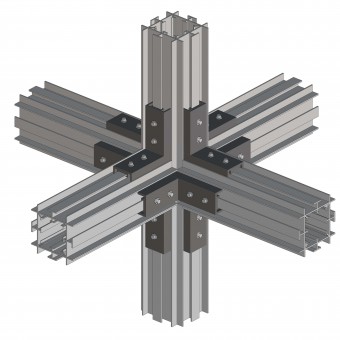 |
|
FS: What is the main principle, idea and inspiration behind your design?
TS: "I come from an architectural engineering background and have always been drawn to the concept of modularity and flexible structure. As a specialist in building construction, I've come to recognize the crucial role of connectors in creating sturdy structures. Whether it's wooden lumbers connected by nails, glue, or bolts, or metal components connected by bolts or welding, these connections significantly contribute to a building's strength. I realized that aluminum extrusions have numerous advantages over traditional wood or metal elements in the realm of human shelter. However, for over a century, effectively connecting two hollow extrusions has posed a problem. Aluminum welding is excessively expensive, and bolting two extrusion elements together doesn't adequately withstand lateral loads. The practice of using aluminum extrusions for building framing has been around since 1904, but it didn't gain popularity in the building industry, primarily due to connection issues of hollow aluminum elements. Companies such as Switzerland's Syma-Systems have attempted to find locking solutions, but their approaches were only suitable for interior framing. Architect Buckminster Fuller's interlocking joint invention for aluminum extrusions, used in geodesic dome structures, marked a significant advancement. After years of research and study, I have developed an improved interlocking clamping system for modular aluminum geometric profiles. This breakthrough allows us to reimagine traditional connector techniques, making building structures more durable, comfortable, efficient, cost-effective, and sustainable. My design lends itself to the creation of recyclable, relocatable, and renewable building structures, significantly contributing to a sustainable future. As an architectural engineer, I take great pride in making a tangible contribution to the evolution of building construction and positively impacting the world around us."
FS: What has been your main focus in designing this work? Especially what did you want to achieve?
TS: "My primary focus in designing this work has been to create a comprehensive building envelope. It incorporates MHS structural aluminum framing, and insulation with solar roofs, and requires minimal demolition, save for doors and windows. This is paired with an emphasis on Indoor Air Quality systems and upgrades in Mechanical, Electrical, and Plumbing (MEP) facets. My overarching goal was to introduce a methodology to construction that could potentially revolutionize the residential sector. Simultaneously, it emphasizes sustainability and effectively caters to the evolving needs and expectations of contemporary homeowners and businesses."
FS: What are your future plans for this award winning design?
TS: "My future plans for this award winning design involve broadening its introduction to building systems globally. The goal is to enable the construction of mass-customizable dwellings, accessory dwelling units (ADUs), and single/multi-family homes. This will be achieved through the integration of an Engineered Frame coupled with customizable architectural finishes, and functional as well as multifunctional spaces. I aim to make significant strides within the industry of modular prefabrication and green building technology."
FS: How long did it take you to design this particular concept?
TS: The development process of this system for me was divided into three phases. I've just concluded the first phase, which took about 10 years to transition from concept to reality. This first phase, spanning from 2013 to 2023, primarily involved research and development. The activities during this phase included establishing domain expertise, developing knowledge systems, acquiring trademarks and patents, performing structural material testing, and ensuring compliance with the building codes of California and Los Angeles. This phase allowed for the experimentation and refinement of technology and manufacturing processes, culminating in the construction of over 400 small structures in Southern California.
FS: Why did you design this particular concept? Was this design commissioned or did you decide to pursuit an inspiration?
TS: "The MHS, designed, patented, and developed by me, Tim M. Siahatgar, an Architectural Engineer based in Irvine, California, is a robust yet lightweight Aluminum Construction System. It was born out of a need for flexible solutions capable of meeting the diverse demands of unique modular projects, thus providing limitless possibilities. This design concept was not a commissioned one, but rather an inspiration that I decided to pursue. In collaboration with designers and contractors, the MHS Structural Aluminum Framing and paneling systems are used to deliver sustainable prefabricated projects. This certified method of modular prefab construction opens up a myriad of architectural possibilities. Whether for residential or commercial buildings, it allows for the construction of structures up to 3 stories high."
FS: Is your design being produced or used by another company, or do you plan to sell or lease the production rights or do you intent to produce your work yourself?
TS: "The modular prefabricated framing design is currently being produced and distributed under a license agreement to other designers and builders. Companies like MHS Building Systems, along with its fabricator licensees and MHS authorized builders, are available to engage in discussions about your next sustainable project. They can provide a range of services from consulting to design and construction. Our innovative construction options offer virtually limitless design and configuration possibilities, only bound by the limits of one's imagination. These solutions allow for the perfect positioning of newly designed homes, offices, or structures on your chosen site, maximizing views, sunlight, and natural features."
FS: What made you design this particular type of work?
TS: "As an architectural engineer with a background in design, I've always been passionate about finding a system to replace lumber framing for light buildings, especially in southern California. The aim was to create something that not only helped the environment and saved trees but was also stronger against earthquake forces and did not contribute to fire hazards. This drive led me to create advanced, innovative designs that blend Modernist style with eco-friendly technology. The products are designed to cater to various sites, locations, and lifestyle needs. We construct the buildings using state-of-the-art, high-tech components, emphasizing the natural essence of materials. The framing design I created leverages virtually everything that can be mechanically attached, reducing reliance on traditional methods like nails and adhesives. Furthermore, it incorporates recycled materials to boost sustainability and value. Our MHS prefab homes offer customers the freedom to choose materials and use them in unique ways, highlighting their versatility and innovation."
FS: Where there any other designs and/or designers that helped the influence the design of your work?
TS: "Throughout my career, I've collaborated with numerous other designers, engineers, and contractors who have influenced my work. An example is Kithaus.com, my Los Angeles fabricator, which has constructed over 500 small prefab structures and has made a name for itself in the modular prefab industry. As the demand for environmentally friendly technology increases, so does the call for more sustainable lifestyles. This is particularly true in the field of construction, where current economic fluctuations highlight the need for improved methods of building homes, apartment buildings, offices, shopping malls, ADUs, and hotels, to name just a few. Recognizing this shift, the city of Los Angeles has issued a 100% approved 'LARR' (Los Angeles Research Report) to MHS, along with local approval, indicating its full support for our innovative building systems, safety measures, environmental technology, and design. These influences and recognitions have significantly shaped the design and development of my work."
FS: Who is the target customer for his design?
TS: "The target customers for this design are primarily homeowners interested in adding Accessory Dwelling Units (ADUs) to their properties to create more luxurious living spaces. However, the design also caters to commercial spaces like shopping malls. Owners of properties that utilize MHS green building practices experience several benefits compared to those of conventional homes. These benefits extend beyond the environmental and include direct advantages such as reduced utility bills due to energy and water efficiency measures, increased comfort with improved temperature control and humidity management, and enhanced environmental quality. The careful construction details, selection of materials with fewer chemicals, and design of air exchange/filtration systems contribute to a healthier indoor environment. So, whether our customers are seeking to enhance residential or commercial spaces, this design offers a wealth of benefits."
FS: What sets this design apart from other similar or resembling concepts?
TS: "What sets the MHS Building Systems Structural Aluminum Framing Design apart from similar concepts is its unique utilization of an expandable clamp with opposing jaws that maintain a significant separation. The system involves frame members that the expandable clamp engages, and at least one pair of opposing end flanges separated by a center rail in a T-shaped configuration. This Modular Aluminum Construction methodology was designed and invented by me, Tim Siahatgar, an architectural engineer. It introduces the Modular Housing System (MHS), a suite of modular structural components designed for swift development. This modern construction system has been at the forefront of aluminum structural technology, particularly in terms of Interlocking Bolting Systems, in recent years. The MHS Building System is an advanced, modular structural design tested and analyzed based on FEMA 461 guidelines, ensuring the safe construction of building structures. Furthermore, shelters built with MHS technology are engineered for both strength and efficiency. We uphold a strict policy of quality control and excellence in manufacturing all modular components and panels. This commitment to quality, innovation, and safety sets our design apart in the field of modular construction."
FS: How did you come up with the name for this design? What does it mean?
TS: "The name 'MHS Building Systems utilizing Structural Aluminum Framing' comes directly from the materials and methodology used in the design. MHS stands for 'Modular Housing System', which reflects the adaptable and versatile nature of the construction system. The 'Structural Aluminum Framing' part of the name highlights the core material - aluminum - used in the framing process. The MHS Prefab Aluminum Post and Beam Framing is designed to be versatile, able to remain exposed to both the interior and exterior of the building or covered with any enclosure building systems based on the architectural design. This name signifies both the modularity and the flexibility of the design approach."
FS: Which design tools did you use when you were working on this project?
TS: "During the early stages of this project, I primarily relied on hand sketches using an ink pen and pencil to conceptualize the design. This traditional method allowed me to capture the initial ideas and shapes, providing a tangible foundation upon which the design could evolve. As the design progressed, I transitioned to digital tools for precision and further development. Depending on the specific needs of the project, I used AutoCAD and Revit for detailed technical drawings and 3D modeling. These software tools helped refine the design, ensuring accuracy and feasibility in the final construction. It's worth noting that when I started my design journey, digital tools like AutoCAD were not available. This experience honed my manual drafting skills, which continue to play an integral role in my design process today."
FS: What is the most unique aspect of your design?
TS: "The most unique aspect of the MHS Aluminum Framing Design lies in its precision, flexibility, and sustainability. The design components are extruded to meet ASTM standards and then pre-cut and fabricated at the factory. Based on project shop drawings and assembly manuals, these structural members and accessories are delivered to the construction site, where a contractor's crew can easily assemble them without the need for heavy equipment. Unlike traditional wood stick-framed homes, MHS homes can be single-story, two-story, or even span three or four levels with shear walls. The system allows for modular spans and open walls, providing significant space savings and offering a modern floor layout and interior design flexibility. Moreover, MHS Prefab Aluminum Framing is resistant to common issues faced by wood, such as shrinking, rotting, warping, buckling, splitting, or attracting insects. This eco-friendly system not only helps to save numerous trees but also results in superior durability, sustainable design, and enhanced energy efficiency, setting it apart from conventional building methods."
FS: Who did you collaborate with for this design? Did you work with people with technical / specialized skills?
TS: "For every new project, collaboration with a diverse team of professionals is key. This includes architects, structural engineers, drafters, and contractors, all bringing their specialized skills to the table. Given that the system provides the primary framework for the building, the involvement of many technical experts is essential. The system itself consists of prefabricated aluminum structural members connected using patented quick-connect bolt and clamp technology. Typically, the MHS is designed to integrate with SIPs or other panels, which fit into the unique channel configurations of the MHS aluminum framing members. The advancement of the aluminum industry, coupled with the evolution of extrusion machinery and the unique characteristics of aluminum, has spurred innovation in building techniques as well as architectural and engineering projects. My collaboration with professionals from these fields has been instrumental in realizing these evolutionary changes."
FS: What is the role of technology in this particular design?
TS: "Technology plays a central role in the MHS Building Systems design. The core of this design is advanced prefabrication, which utilizes state-of-the-art techniques to create innovative connections between aluminum framing components. This modernist style, when coupled with eco-friendly technology, allows for the construction of buildings that cater to diverse sites, locations, and lifestyle needs. The buildings are crafted using cutting-edge components, with an emphasis on highlighting the natural properties of the materials used. A unique aspect of the MHS design is its mechanical attachment methodology. By using this technique, we are able to significantly reduce reliance on traditional methods like nails and adhesives. In addition, the incorporation of recycled materials underlines our commitment to sustainability and value. This advanced technology enables us to offer prefab homes that give customers the freedom to choose and use materials in a unique way. Therefore, technology is not just a tool but a crucial element that defines the uniqueness and functionality of the MHS Structural Aluminum Framing Design."
FS: Is your design influenced by data or analytical research in any way? What kind of research did you conduct for making this design?
TS: "Certainly, data and analytical research are integral parts of my design process. Any new design, especially one as complex and novel as the MHS Structural Aluminum Framing Design, requires comprehensive research and data analysis. In developing this design, I conducted a series of research initiatives that spanned various facets of the design process. Firstly, I carried out extensive market research to identify and understand the needs and preferences of potential customers. This helped in shaping a design that is both functional and appealing to the target market. Additionally, I delved into technical research to ensure the design's structural integrity, safety, and longevity. This involved studying various materials, their properties, and their suitability for the intended design. Lastly, my design was heavily influenced by environmental research. I aimed to create a sustainable solution that would minimize environmental impact, hence, I extensively studied different eco-friendly materials and construction techniques. I also analyzed data on the environmental impacts of conventional building methods to highlight the benefits of my design. Therefore, my design is a result of a meticulous blend of market, technical, and environmental research, ensuring that it is robust, practical, sustainable, and aligned with the needs of the target market."
FS: What are some of the challenges you faced during the design/realization of your concept?
TS: Realizing the MHS Structural Aluminum Framing Design presented various challenges, one of the most significant being the process of obtaining construction approvals due to the differences in local building codes across different regions. Different jurisdictions have varying building codes and regulations, each of which required me to modify or adapt my design to ensure compliance. This process was time-consuming and often necessitated numerous revisions to the original design. Another challenge I encountered was in the realm of technological adaptation. As my design utilizes advanced construction techniques, there was a learning curve for the construction crews involved. I had to devote substantial time to training and education to ensure the techniques were correctly applied. Finally, sourcing the right materials also posed a challenge. The design uses high-quality, eco-friendly materials, some of which were not readily available. This required careful planning and logistics management to ensure that these materials could be procured without delaying the project. Overcoming these challenges was a crucial part of the design realization process, and the experience gained has been invaluable in refining the design and optimizing the construction process."
FS: How did you decide to submit your design to an international design competition?
TS: "Deciding to submit my design to an international design competition was a strategic choice driven by a few key factors. Firstly, I believe in the innovation and potential impact of the MHS Structural Aluminum Framing Design. I see it as a game-changer in the construction industry, offering a unique blend of functionality, aesthetic appeal, and sustainability. I felt it was important to share this innovation on a global platform to bring awareness and encourage its adoption across the world. Secondly, participation in such a competition presents an opportunity to receive professional critique and feedback. It's a great chance to learn from industry leaders and experts, which can help refine the design further. Lastly, international recognition can significantly boost the visibility and credibility of the design. It can open up opportunities for collaborations, partnerships, and even business expansion. Therefore, while we're still in the preparation phase, we're eagerly looking forward to submitting our project to international design competitions."
FS: What did you learn or how did you improve yourself during the designing of this work?
TS: "The design process of this project has been a transformative journey of continuous learning and self-improvement. As we completed phase 1 of the development, I found that every challenge we faced presented an opportunity for me to grow as an architectural engineer and refine the system. One of the crucial insights I've gained during this phase is the importance of adaptability and continuous evolution in design. As we move forward to phase 2 of the development, I realize the need to integrate and adapt to the insights and learning gained from phase 1. In phase 2, our focus is on enhancing the seismic resilience of MHS's framing by subjecting it to rigorous testing. Our intention is to simulate a series of large earthquakes, ranging from 4 to 8 on the Richter scale, to analyze their impact on a full-scale 2-3 story MHS structural aluminum framing building. This testing will be carried out utilizing the world's largest outdoor shake table located at the University of California, San Diego. So, in essence, the learning curve has been steep, but every step of the way has added valuable knowledge, refined my skills, and honed my approach towards innovative architectural design."
FS: Any other things you would like to cover that have not been covered in these questions?
TS: "I'd like to emphasize the broader impact of this design. Beyond its technical specifications and aesthetic appeal, I see it as a transformative solution that can positively affect society and our environment. My design philosophy centers on the belief that architecture should not only meet functional needs but also consider its impact on the world around us. This design, in particular, reflects an effort to contribute to a greener and more sustainable future. It offers potential benefits to various stakeholders - from homeowners who will live in these spaces, to engineers and designers who can utilize this system for innovative solutions, and to investors who can see value in green, sustainable, and efficient construction. I'm eager to explore potential collaborations that can leverage this system to create innovative, sustainable, and aesthetically pleasing built environments. You can reach out to us at office@modularhousingsystems.com for any inquiries or potential collaborations. Let's build a more sustainable future together."
FS: Thank you for providing us with this opportunity to interview you.
A' Design Award and Competitions grants rights to press members and bloggers to use parts of this interview. This interview is provided as it is; DesignPRWire and A' Design Award and Competitions cannot be held responsible for the answers given by participating designers.
| SOCIAL |
| + Add to Likes / Favorites | Send to My Email | Comment | View Press-Release | Translations |
